Recorded Crime in Scotland, 2014-15
Official Statistics Bulletin presents statistics on crimes and offences recorded and cleared up by the police in Scotland. It forms part of the Scottish Government series of statistical bulletins on the criminal justice system. Statistics on crimes and offences recorded by the police provide a measure of the volume of criminal activity with which the police are faced.
3. Main Findings: Recorded Crimes and Offences in Scotland
Total Recorded Crime
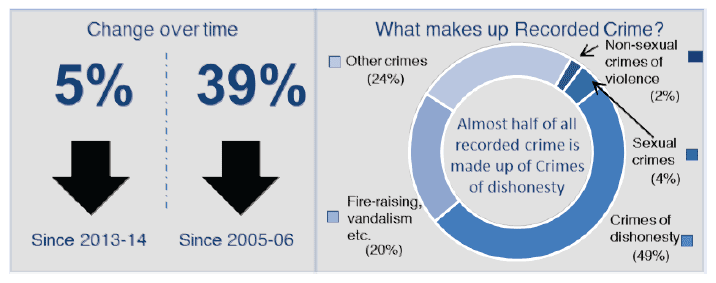
Recorded crime is at its lowest level since 1974. The total number of crimes recorded by the police in Scotland in 2014-15 was 256,350. This is 5% lower than the level recorded in 2013-14 (Chart 1 and Table 5). Other than a slight increase in 2006-07, crime has been on a downward trend in Scotland since 2005-06, having decreased overall by 39%. This continues a steadily decreasing trend in recorded crime in Scotland over the last 24 years, from a peak in 1991 when crime reached a record high of 572,921.
Chart 1: Total crimes recorded by the police, 1971 to 1994 then 1995-96 to 2014-15

Chart 2 shows the number of recorded crimes in each of the five crime groups since 1971 and gives an indication of the scale of each crime group. At 49%, Crimes of dishonesty account for almost half of all recorded crime in 2014-15. This was followed by Other crimes (24%), Fire-raising, vandalism etc. (20%), Sexual crimes (4%) and Non-sexual crimes of violence (2%). These individual groups will be discussed in more detail in the sections which follow.
Chart 2: Crimes recorded by the police by crime group, 1971 to 1994 then 1995-96 to 2014-15
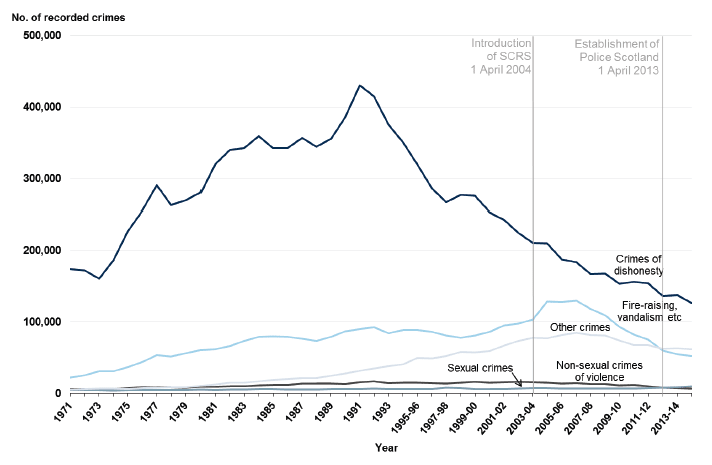
Local Authority analysis:
The overall decrease in recorded crime was reflected in 23 of the 32 local authority areas, with four experiencing an increase and five with very little change from the previous year. Year on year figures can vary across local authorities, however the long term trend is broadly the same across Scotland. Chart 4 shows that since 2005-06, all local authorities are showing a decrease in recorded crime, varying from 27% in East Ayrshire to 61% in Eilean Siar.
The largest fall in recorded crime in 2014-15 was in Moray (18%) where 55% of the decrease was accounted for by decreases in Other theft and Vandalism etc. In Aberdeenshire and Highland, the overall decrease was 17%. In Aberdeenshire, 84% of the decrease was accounted for by reductions in Other theft, Housebreaking and Vandalism etc. In Highland, Other theft, Vandalism etc. and Shoplifting accounted for 71% of the overall decrease.
The largest numerical decrease was in Glasgow City, falling by over 3,000 crimes from 50,823 in 2013-14 to 47,758 in 2014-15. Glasgow City, which includes 11% of Scotland's population[1], continues to account for 19% of all recorded crime in Scotland.
Four local authorities had an increase in recorded crime: Stirling (9%), East Ayrshire (4%), East Renfrewshire (3%) and Midlothian (3%). In Stirling, 71% of the increase was accounted for by Other theft and Housebreaking. In East Ayrshire, the increase was driven by increases in Drugs and Shoplifting. In East Renfrewshire, the increase was accounted for by an increase in Drugs crimes, while in Midlothian the increase was due to an increase in Other theft and Vandalism etc.
Five local authority areas (Perth & Kinross, the City of Edinburgh, Clackmannanshire, the Shetland Islands and Inverclyde) saw very little change in recorded crime between 2013‑14 and 2014-15 (Chart 3).
Further explanation of these trends is set out in the following sections for each crime group. Please note that further local authority level data for Tables 5-8 can be accessed online via the following link: http://www.gov.scot/Topics/Statistics/Browse/Crime-Justice/Datasets/RecCrime.
Chart 3: Change in total recorded crime between 2013-14 and 2014-15, by local authority area
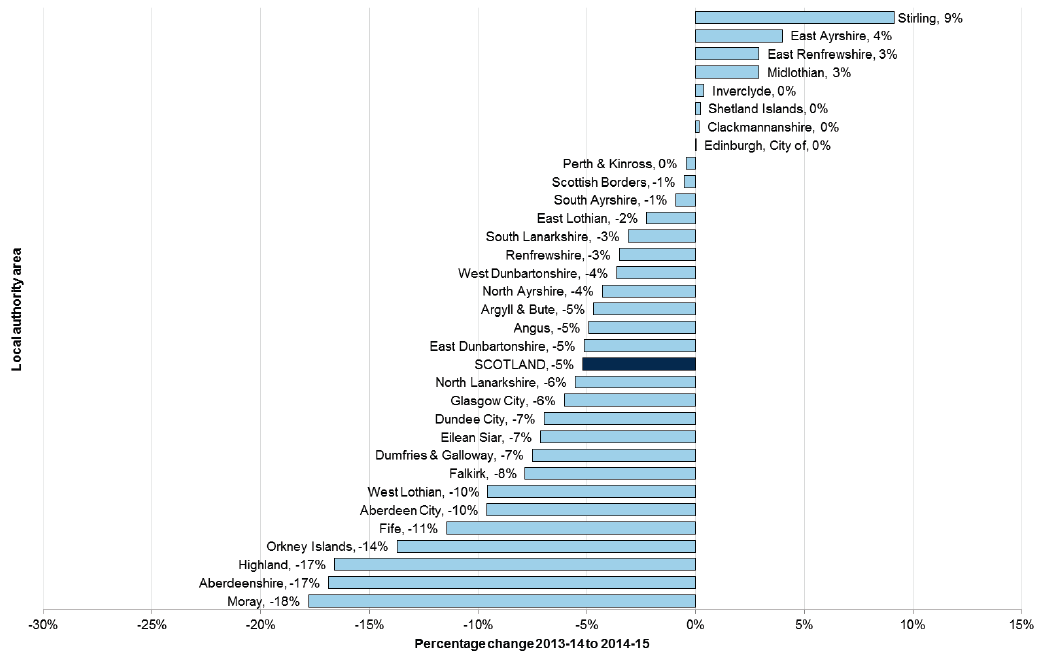
Chart 4: Change in total recorded crime between 2005-06 and 2014-15, by local authority area
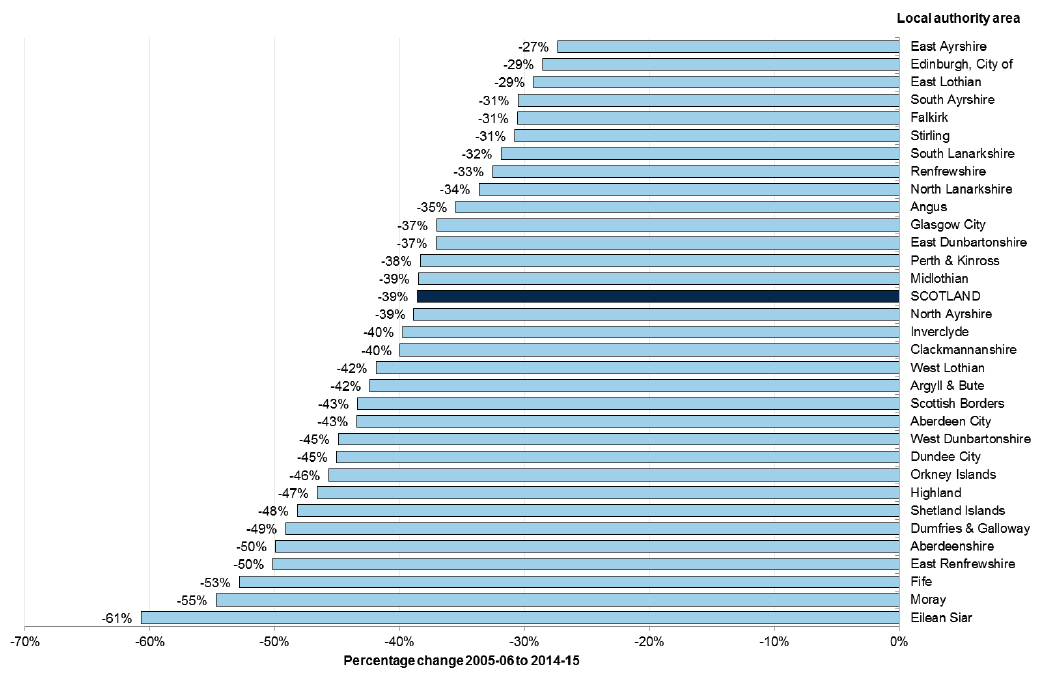
Crime rate per 10,000 population
There were 479 recorded crimes per 10,000 population in 2014-15, with urban areas recording the highest rates; Glasgow City (796 per 10,000 population), the City of Edinburgh (723 per 10,000 population), Aberdeen City (608 per 10,000 population) and Dundee City (578 per 10,000 population) (Table 11).
Chart 5: Total number of recorded crimes per 10,000 population1 in 2014-15
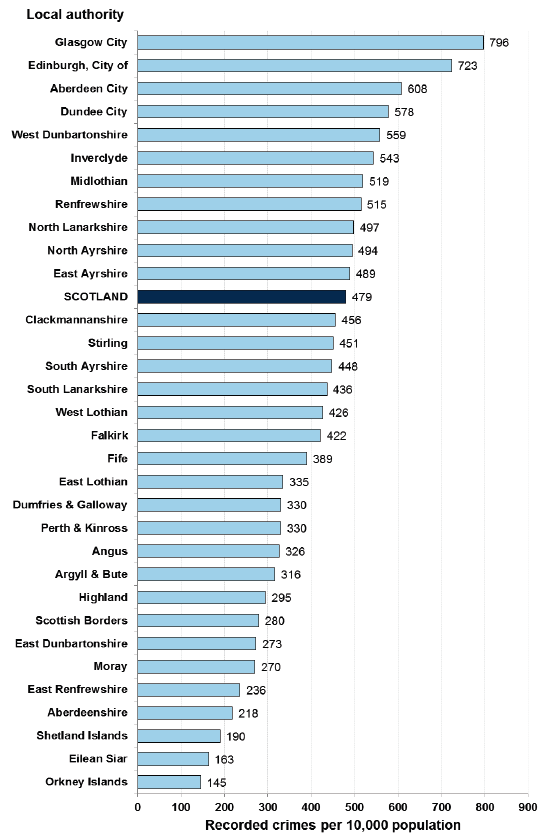
1. Population estimates are as at mid-year 2014 from the National Records of Scotland
(http://www.nrscotland.gov.uk/statistics-and-data/statistics/statistics-by-theme/population/population-estimates/mid-year-population-estimates)
Clear up rates
The clear up rate for total recorded crimes decreased by 1.1 percentage points from 51.5% in 2013-14 to 50.4% in 2014-15. Clear up rates remain higher than for most of the period since 2005-06 (Table 7).
Chart 6: Clear up rates for crimes recorded by the police by crime group, 19761 to 1994 then 1995-96 to 2014-15
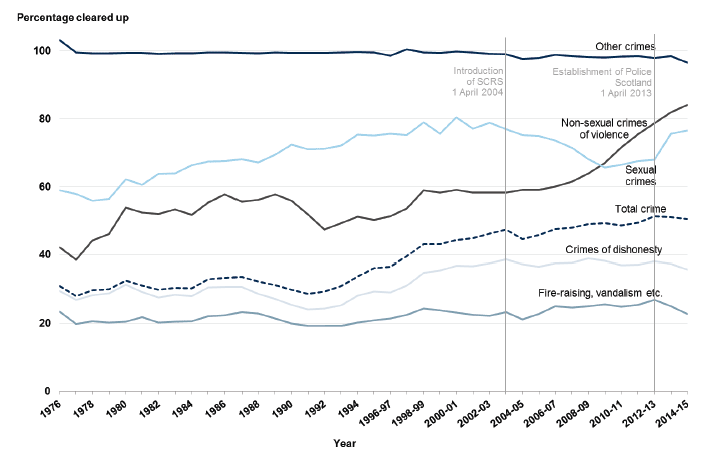
1. Comparable clear up rates for the present crime groups are not available prior to 1976.
Official Statistics on total recorded crime are based on data which Police Scotland extract from their IT system (called the Scottish Operational and Management Information System (ScOMIS)) and submit to the Scottish Government. Prior to 2013-14 and the establishment of Police Scotland, the Scottish Government collected recorded crime data from the eight legacy forces, who in turn extracted the data from their own systems.
Despite the change in method of collection, the data presented in this section on total recorded crime (which comprises of Crime Groups 1 to 5) remains comparable both before and after 1st April 2013. The Scottish Government produced a Technical Report in 2014 which detailed the quality assurance work it carried out in reaching this conclusion: http://www.gov.scot/Topics/Statistics/Browse/Crime-Justice/PubRecordedCrime/TechnicalReport.
On 1 April 2004, the Scottish Crime Recording Standard (SCRS) was introduced to help maintain a victim orientated approach to crime recording. It was anticipated that this might increase the number of minor crimes recorded such as vandalism and minor thefts. It can be seen from Chart 1 that this did cause a slight increase in 2004-05 as expected, but that the downwards trend returned following this change to recording practice.
DATA VALIDATION
HMICS Crime Audit 2014: Background
This bulletin reports on the number of crimes and offences recorded by the police in Scotland. On 12 November 2014, Her Majesty's Inspectorate of Constabulary in Scotland (HMICS) published Crime Audit 2014, which assessed the extent to which police recording practices complied with the Scottish Crime Recording Standard and the Scottish Government's Counting Rules: http://www.hmics.org/publications/hmics-crime-audit-2014.
This was the largest crime recording audit undertaken by HMICS. It audited incidents reported between 1 April 2013 and 30 June 2014, and was the first crime audit in which a timeliness test was applied. When carrying out their audit of recorded crime accuracy, HMICS took into account areas identified as weak in previous audits, areas of high risk or emerging concern, and national and local policing priorities. HMICS audited records in six categories, four of which related to specific crime types:
- Sexual crime
- Violent crime
- Housebreaking
- Hate crime
- Non-crime related incidents
- No-crimes
HMICS Crime Audit 2014: National Results
The Audit found no systemic data quality issues around the recording of crimes and offences. The report found that 'the quality of most incident and crime recording decisions by Police Scotland is good. 92% of incidents were closed correctly[2] and 94% of crime was counted and classified correctly'.
The report also showed that 94% of the almost 1,000 cases which were initially thought to be a crime but were later re-designated as not being a crime following additional investigation, were found to have been no-crimed correctly.
The audit identified that there were some incident records which had not been closed correctly for various reasons. However, the technical errors found by HMICS in its examination of non-crime related incidents would not necessarily result in the under-recording of crime. Furthermore, it was not possible to determine the exact number of incident records which should have indicated that a crime had occurred, as many were closed with insufficient information from which to make such a judgment.
HMICS Crime Audit 2014: Divisional Results
The Audit report states that 'a few divisions performed very well, achieving high compliance rates in all or most areas'. However, the report goes on to state that 'conversely, a few divisions performed poorly'.
Divisional compliance rates for Test 1 (whether an incident was closed correctly) ranged from 83% to 99% and for Test 2 (whether a crime was counted and classified correctly) from 88% to 98%.
The Test 1 compliance rate was 90% or below for four of the 14 divisions, namely Edinburgh, Ayrshire, Argyll and West Dunbartonshire, and Renfrewshire and Inverclyde. Furthermore, the no-crime compliance rate was below 90% for the last three of these divisions. The lowest Test 2 compliance rate was for Ayrshire at 88%.
Readers should be aware of these factors when considering information relating to these four divisions. The following table shows the local authorities within these divisions:
| Division |
Local authorities |
|---|---|
| Edinburgh |
City of Edinburgh |
| Ayrshire |
East Ayrshire, North Ayrshire and South Ayrshire |
| Argyll and West Dunbartonshire |
Argyll & Bute and West Dunbartonshire |
| Renfrewshire and Inverclyde |
Renfrewshire and Inverclyde |
HMICS Crime Audit 2014: Conclusion for the Official Statistics
Overall this audit demonstrates that users of crime statistics can have confidence that crimes are being classified and counted correctly.
As outlined above, users should be aware that crime statistics for some local authorities will be based on police divisions with lower compliance than the national average. Furthermore, as the audit is based on a sample survey of incident and crime records (rather than all records), the true value may differ slightly from the results in the audit. This is because sampling in this way is always subject to a range of quantifiable and non-quantifiable error. Further information on this is provided within the Appendix of the Audit report.
Further details from this audit in relation to compliance rates for specific crime types and divisional information are provided within the relevant sections of this bulletin as well as in Annex 3.
DATA COMPARISONS
In addition to the information on police recorded crime, crime in Scotland is also measured by the Scottish Crime and Justice Survey (SCJS), a national survey with adults (aged 16 and over) living in private households which asks respondents about their experiences of crime.[3] A comparison of the two sources is provided below.
Comparison with recorded crime (comparable crime subset):
Of the 815,000 crimes estimated by the 2012-13 SCJS, just under two-thirds (527,000) can be compared with police recorded crimes. Further detail on the comparable crime set is available in Section 4.3 and in Annex 5 of the 2012-13 SCJS.
Both recorded crime figures and SCJS estimates show downward trends in the extent of comparable crime between 2008-09 and 2012-13 (-33% and -28% respectively). The reduction in estimates across all sweeps of the SCJS, from 731,000 in 2008-09 to 527,000 in 2012-13, is a statistically significant change. However, the short-term change in SCJS comparable crime between 2010-11 and 2012-13 is not a statistically significant change (at the 95% confidence level).
At this stage, it is difficult to identify trends in the relationship between recorded crime and SCJS estimates using only four sweeps of comparable data and we do not have enough evidence to make confident assertions about longer-term trends in SCJS estimates in the comparable crime subset prior to 2008-09. It is likely that greater certainty in trends will emerge over longer timescales, and therefore continuing this analysis in future years will help to assess whether some of the short term changes reported here mark the beginning of a consistent pattern. Comparisons between police recorded crime data and SCJS estimates will be updated within the 2014-15 SCJS publication, scheduled for the first quarter of 2016.
Group 1 - Non-sexual Crimes of Violence
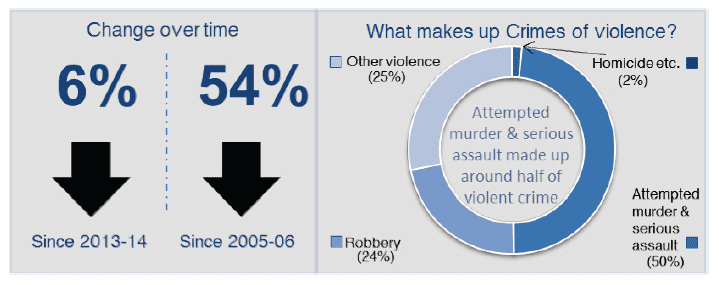
Number of Non-sexual crimes of violence recorded in 2014-15:
Non-sexual crimes of violence account for 2% of all crimes recorded in Scotland in 2014‑15. Between 2013-14 and 2014-15, the number of Non-sexual crimes of violence recorded by the police in Scotland decreased by 6%, from 6,785 to 6,357.
Chart 7 below shows the number of Non-sexual crimes of violence from 1971 onwards. Levels of violent crime increased for a long period, before entering a downward trend in 2002-03, having decreased by 60% since that time. These crimes are at their lowest level since 1974.
Chart 7: Non-sexual crimes of violence recorded by the police, 19711 to 1994 then 1995‑96 to 2014-15
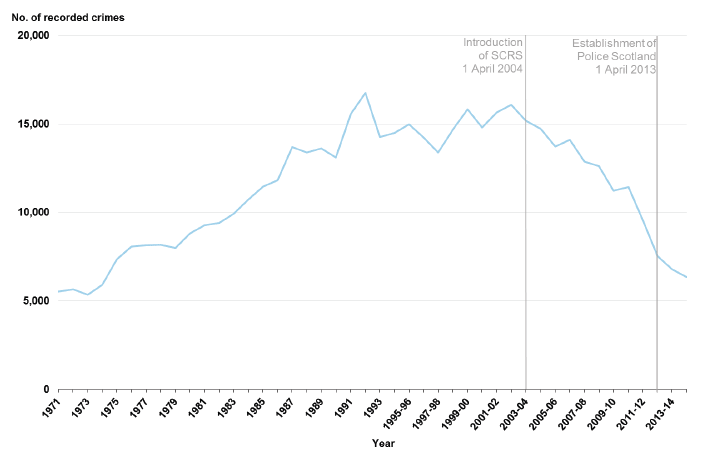
1. Crimes recorded for the present crime groups are not available prior to 1971.
In 2014-15, the rate of recorded Non-sexual crimes of violence for Scotland decreased to 12 crimes per 10,000 population, compared to 13 per 10,000 population for 2013-14. This varied by local authority area, with the highest rate in Glasgow City (23 per 10,000 population), and the lowest in Eilean Siar, the Orkney Islands and the Shetland Islands (4 per 10,000 population).
Chart 8 shows the four categories within Non-sexual crimes of violence over the last ten years, and gives an indication of the trend and scale of each category. The proportions of all categories across the group have remained fairly steady over the ten year period from 2005-06 to 2014-15, despite their decreasing levels. Attempted murder and serious assault made up around one half of all Non-sexual crimes of violence, with Robbery and Other violence being around one quarter each, and Homicide etc. contributing a very small proportion to the total.
Chart 8: Non-sexual crimes of violence in Scotland, 2005-06 to 2014-15
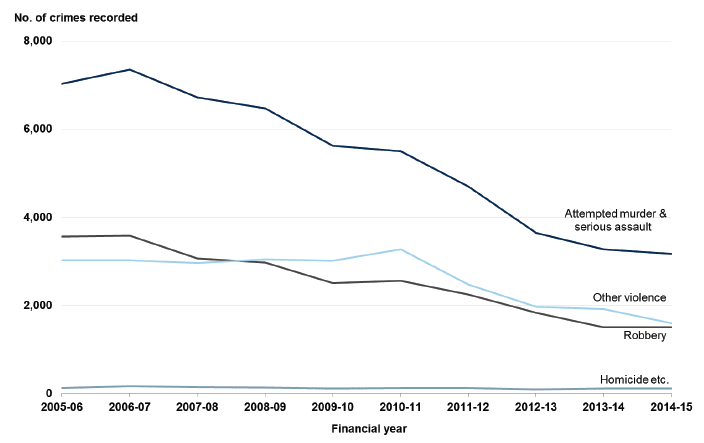
Attempted murder & serious assault:
Attempted murder & serious assault is the largest category in Group 1, accounting for around half of all Non-sexual crimes of violence. Over the ten year period from 2005-06 to 2014-15, this category has seen a large decrease of 55%, and has decreased by 3% from 3,268 in 2013-14 to 3,166 in 2014-15.
All local authorities have recorded a decrease in this category over the ten year period, with the exception of East Lothian which has increased by 6%. The national decrease in 2014-15 was reflected in a minority of local authority areas, with 16 areas showing an increase ranging from 2% in West Dunbartonshire to 67% in Moray. The overall decrease from the previous year was driven by a 10% decrease in Glasgow City, which accounts for around one quarter of crimes in this category.
For the definition of Serious assault and the distinction between Serious assault and Common assault please see Paragraph 6.9 within Annex 1.
Robbery:
Robbery accounts for around one quarter of Non-sexual crimes of violence. Over the ten year period from 2005-06 to 2014-15, this crime has seen a large decrease of 58%. Levels remained practically unchanged between 2013-14 and 2014-15, decreasing by just 2 crimes to 1,497.
Three quarters of all local authority areas recorded a decrease in this category over the ten year period. Of those that increased, all changes were based on small numbers with only one change of greater than 5 crimes. Between 2013-14 and 2014-15, as many local authorities showed a decrease as showed an increase.
Homicide etc.:
As well as Murder and Culpable homicide (common law), the Homicide etc. category included in this bulletin contains the crimes of:
- Causing death by dangerous driving;
- Causing death by careless driving when under influence of drink or drugs;
- Causing death by careless driving;
- Illegal driver involved in fatal accident; and
- Corporate homicide.
Homicide etc. accounts for under 2% of Non-sexual crimes of violence. This category has fluctuated over the ten year period from 2005-06 to 2014-15. During the latest year, it decreased by 1% from 106 in 2013-14 to 105 in 2014-15.
Over the ten year period covering 2005-06 to 2014-15, there has been a 50% decrease in Homicide etc. in Glasgow City. As such, the proportion of all crimes of Homicide etc. that take place within Glasgow has fallen from 26% in 2005-06 to 15% in 2014-15. Between 2013-14 and 2014-15, almost two thirds (63%) of local authorities showed either a decrease or very little change in the level of Homicide etc.
Other violence:
The Other violence category includes crimes such as Cruel and unnatural treatment of children, Threats and extortion, and Abduction, which together account for more than 90% of the crimes within this category. More detail is provided in Chapter 7.
Crimes recorded as Other violence account for one quarter of Non-sexual crimes of violence. These crimes are at the lowest level since 1988. Over the ten year period from 2005-06 to 2014-15, this category has seen a large decrease of 47%, and has decreased by 17% from 1,912 in 2013-14 to 1,589 in 2014-15. The decrease from the previous year was mainly driven by a reduction in the volume of crimes of Cruel and unnatural treatment of children and Threats and extortion.
Additional information provided by Police Scotland relating to recording practices for crimes of Cruel and unnatural treatment of children is available in the 'Data Considerations' section below.
Over the ten year period, the majority (26) of local authorities recorded a decrease in this category. This trend continued between 2013-14 and 2014-15 with almost three quarters (23) of local authorities showing a decrease.
Clear up rates for Non-sexual crimes of violence in 2014-15:
The clear up rate for Non-sexual crimes of violence increased by 2.2 percentage points from 81.9% in 2013-14 to 84.1% in 2014-15, continuing a longer term trend. The clear up rate for Group 1 crimes ranged from 112.7% in Argyll & Bute to 66.4% in Inverclyde.
Clear up rates in each of the four categories in this crime group have also increased, with the largest increase in the clear up rate noted in Homicide etc., which increased from 101.9% to 107.6%.
Rates of over 100% can occur when crimes are cleared up in a different reporting period to the year in which they were recorded.
DATA VALIDATION
HMICS Crime Audit 2014
It should be noted that in the HMICS audit report, violent crime includes Common assault (the figures for which are included in this bulletin under Group 6 - Miscellaneous offences). Further information on this audit, including definitions of terminology and tests used, can be found in Annex 3.
Of the 1,766 crimes examined in the audit that resulted from violent incidents, 94% were counted and classified correctly.
The audit found that a number of crimes had been under-counted (38) or over-counted (31). Most of the under-counted crimes were for common assault; most of the over-counted crimes related to common assault or threatening and abusive behaviour.
A number of crimes (38) were classified incorrectly. The majority of these fell into three categories:
- common assault which should have been serious assault (14);
- serious assault which should have been attempted murder (7);
- thefts, or assaults and thefts, which should have been robberies (10).
The HMICS audit report notes that the 'classification of serious assault continues to be a challenge'. As noted in the report, a review is currently underway by Police Scotland, in conjunction with the Scottish Government and other criminal justice partners, on the definition of serious assault.
Of the 2,238 violent incidents[4] examined in the audit, 92% were closed correctly.
Almost half of the incidents which failed Test 1 involved a report of violence (usually a common assault) where the complainer was uncooperative. Around a third of the Test 1 fails involved a lack of information or update on the incident record to dispel the initial report of criminality.
DATA COMPARISONS
This segment includes information that should be considered to widen contextual understanding of the data provided on Group 1 - Non-sexual crimes of violence. Detail is provided both on a separate bulletin on Homicide, as well as analysis from the SCJS to provide a complementary outlook on violent crime in Scotland.
Homicide
A separate Homicide in Scotland bulletin is produced by the Scottish Government that contains more detailed information on the crimes of Murder and Culpable homicide (common law). The data contained within the Homicide bulletin will differ from the data presented here for the following reasons:
- The Homicide in Scotland bulletin does not cover all of the crimes included within the Homicide etc. category per this bulletin (as detailed above), such as Causing death by dangerous driving and Corporate homicide.
- The data in the Homicide in Scotland bulletin are collected from the police separately to the data presented in this bulletin and are collected on an individual case basis. This allows characteristics of victims and accused, such as age and gender, as well as the circumstances of the homicide, to be collected and then included in the bulletin.
- The data are extracted from police recording systems at different time points, which may result in reclassification of crimes, such as attempted murder to murder, not being revised in the collections for this bulletin, but are reflected in the Homicide in Scotland bulletin.
We therefore recommend that users interested in Homicide statistics should refer directly to the Homicide in Scotland bulletin series, which can be accessed at: http://www.gov.scot/Topics/Statistics/Browse/Crime-Justice/PubHomicide.
The next Homicide in Scotland statistical bulletin will contain data for 2014-15 and is scheduled to be published on 29 September 2015.
Scottish Crime and Justice Survey (SCJS)
In addition to the information on police recorded crime, crime in Scotland is also measured by the SCJS, a national survey with adults (aged 16 and over) living in private households which asks respondents about their experiences of crime.
It should be noted that violent crime as defined by the SCJS is not directly comparable with non-sexual crimes of violence recorded by the Police. Non-sexual crimes of violence (as used in police recorded crime) includes homicide, whilst common assaults (which make up the majority of SCJS violent crime) are included in this bulletin under Group 6 - Miscellaneous Offences. A more detailed examination of comparisons between the SCJS and recorded crime is made within Chapter 4.
Key points from the Scottish Crime and Justice Survey:
Of the 815,000 crimes measured by the SCJS in 2012-13, 236,000 (29%) were violent crimes. It is estimated that around 3% of adults in Scotland were a victim of violent crime in 2012-13.
In 2012-13, minor assaults made up the majority of SCJS violent crime (23%), followed by attempted assault (3%), serious assault (2%) and robbery (1%).
Further detail on the comparable crime set is available in Section 4.3. As outlined there and in Annex 5 of the 2012-13 SCJS, violent crime in the SCJS includes attempted assault, serious assault, minor assault and robbery, crimes which are included in Group 1 (Non-sexual crimes of violence) and Group 6 (Miscellaneous offences) in police recorded crime figures.
As outlined in Section 4.3, between 2008-09 and 2012-13, recorded violent crime figures in the comparable category decreased by 20%, while, for the same period, the SCJS estimates of violent crime decreased by 25%, a statistically significant change in the SCJS results. As indicated by Table 3, the SCJS is often better able to detect changes in survey estimates with greater certainty over longer timescales, particularly where the prevalence of crime is low, i.e. in part due to the small numbers of victims identified in the survey (343 for violent crime in 2012-13).
Group 2 - Sexual Crimes
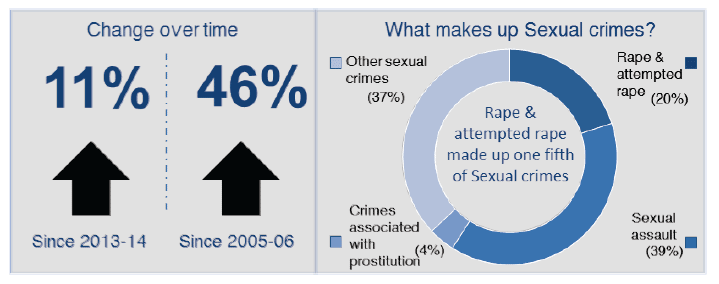
Number of Sexual crimes recorded in 2014-15:
Sexual crimes account for 4% of all crimes recorded in Scotland in 2014‑15. The number of Sexual crimes recorded by the police in Scotland increased by 11% from 8,604 in 2013-14 to 9,557 in 2014-15.
Chart 9 below shows the number of Sexual crimes from 1971 onwards. Sexual crimes have been on a long-term upward trend since 1974, and have increased each consecutive year since 2008-09. Sexual crimes are at the highest level since 1971, the first year for which comparable crime groups are available.
Chart 9: Sexual crimes recorded by the police, 19711 to 1994 then 1995‑96 to 2014-15
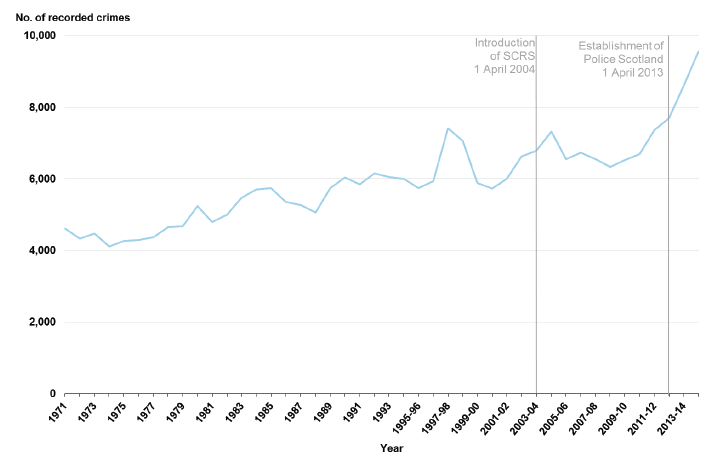
1. Crimes recorded for the present crime groups are not available prior to 1971.
In 2014-15, the rate for Scotland of recorded Sexual crimes increased to 18 crimes per 10,000 population, compared to 16 per 10,000 population for 2013-14. This varied by local authority area, with the highest rate in Dundee City (37 per 10,000 population), and the lowest in East Renfrewshire (6 per 10,000 population).
Whilst the specific age of the victim cannot generally be determined from the data supplied by Police Scotland, many of the sexual offence crime codes used by the Police to record crime make it clear when the victim was aged under 18 (for example, Sexual assault of older male child (13-15 years)). By adding up all those crime codes, we know that at least 32% of the 9,557 sexual offences recorded in 2014-15 by the police related to a victim under the age of 18.
Chart 10 below shows the four categories within Sexual crimes over the last ten years, and gives an indication of the trend and scale of each category. The proportions of the Sexual assault and Other sexual crimes categories have changed markedly over time, almost converging after 2010, which coincides with the implementation of the Sexual Offences (Scotland) Act 2009. Information on the impact of this Act is available under Data Considerations below. The proportion of Rape and attempted rape has remained fairly constant over time, whereas that of Crimes associated with prostitution has fallen.
Tables A2 and A3 contain more detailed breakdowns for Sexual crimes.
Chart 10: Sexual crimes in Scotland, 2005-06 to 2014-15
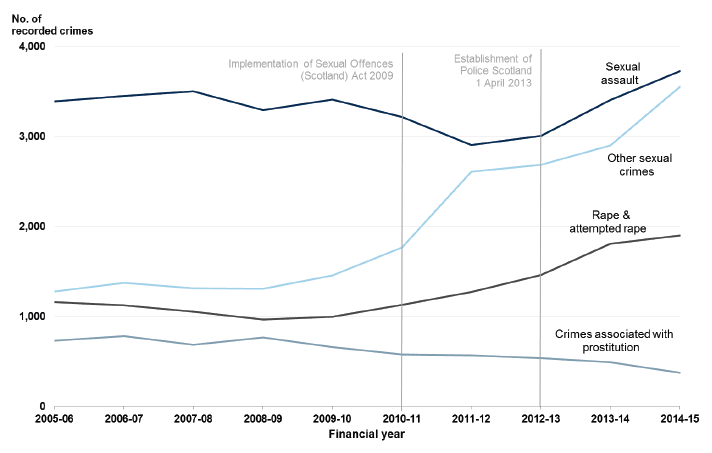
Sexual assault:
Sexual assault is the largest category in Group 2, accounting for 39% of Sexual crimes in 2014‑15. This category has seen an increase of 10% over the ten year period from 2005-06 to 2014-15, and has increased by 9% from 3,405 in 2013-14 to 3,727 in 2014-15. This category has been on an upward trend since 2011-12, having increased by 28% since that time.
This trend is not seen across the whole of Scotland, as just over half (17) of local authorities have recorded an increase in this category over the ten year period. Between 2013-14 and 2014-15, a similar number (19) of local authority areas showed an increase in Sexual assault. Notably, South Lanarkshire increased by 67% from 90 crimes in 2013-14 to 167 in 2014-15. While this local authority accounts for only 4% of the crimes in this category, this increase is the equivalent of almost a quarter (24%) of the overall change in Sexual assault and 8% of the overall change in Sexual crimes as a whole.
One of the main drivers behind the increase in Sexual assault between 2013-14 and 2014-15 was an increase in crimes of Sexual assault of a female (16+), accounting for 31% of all crimes within this category.
Rape & attempted rape:
It should be noted that due to the implementation of the Sexual Offences (Scotland) Act 2009, comparisons with data prior to 2010-11 should be treated with caution. Additional information relating to the implementation of this legislation is available in the 'Data Considerations' section below.
Rape & attempted rape accounts for 20% of Sexual crimes. These crimes have increased by 68% between 2010-11 and 2014-15, and have increased by 5% from 1,808 in 2013-14 to 1,901 in 2014-15.
Almost all local authority areas recorded an increase in this category over the five year period from 2010-11 to 2014-15, with only the Shetland Islands and East Dunbartonshire showing a decrease over this time (both based on small numbers). This trend continued between 2013-14 and 2014-15 with the majority (19) of local authorities showing an increase from the previous year.
Crimes associated with prostitution:
Crimes associated with prostitution account for less than 4% of Sexual crimes. Over the ten year period from 2005-06 to 2014-15, these crimes have seen a large decrease of 49%, and have decreased by 24% from 490 in 2013-14 to 374 in 2014-15.
Almost all crimes within this category (97%) are recorded in the city based local authority areas covering Edinburgh, Glasgow, Aberdeen and Dundee. All four of these recorded a decrease over the ten year period. This trend continued between 2013-14 and 2014-15, with the exception of Dundee which saw an increase of 127% from 15 in 2013-14 to 34 in 2014-15.
Other sexual crimes:
The Other sexual crimes category includes crimes such as Other sexually coercive conduct, Other sexual crimes involving 13-15 year old children, Taking, distribution, possession etc. of indecent photos of children, Incest, Illegal homosexual acts, Indecent exposure and Other sexual crimes.
As with Rape & attempted rape, it should be noted that due to the implementation of the Sexual Offences (Scotland) Act 2009, comparisons with data prior to 2010-11 should be treated with caution. Additional information relating to the implementation of this legislation is available in the 'Data Considerations' section below. As of 2014-15, a new crime code for Possession of extreme pornorgraphy was introduced and included in the Other sexual crimes category. Previously these crimes would have been classified as offences of Handling obscene material within Group 6 - Miscellaneous offences, under the Other miscellaneous offences category. The overall impact of this change on the Other sexual crimes category is very small, with Possession of extreme pornography accounting for 0.7% of Other sexual crimes and 0.3% of total Group 2 Sexual crimes in 2014-15.
Other sexual crimes account for over one third (37%) of Sexual crimes. This category has been on an upward trend since 2010-11, having increased by 101% within that time, and increased by 23% between 2013-14 and 2014-15.
All local authority areas recorded an increase in this category over the five year period from 2010-11 to 2014-15, ranging from 11% in North Ayrshire to 545% in Angus, with more than half of local authorities (17) showing an increase of at least 100%. This trend continued between 2013-14 and 2014-15 with the majority (25) of local authorities showing an increase from the previous year.
Clear up rates for Sexual crimes in 2014-15:
The clear up rate for Sexual crimes increased by 0.9 percentage points in 2014-15 from 75.6% to 76.5%, continuing the upward trend since 2009-10. This rate ranged from 96.7% in the Shetland Islands to 62.0% in Midlothian.
Clear up rates have also increased in all categories of Sexual crimes, except for Other sexual crimes which decreased from 79.4% to 75.5%.
Sexual Offences (Scotland) Act 2009
The implementation of the Sexual Offences (Scotland) Act 2009 on 1 December 2010, resulted in a redistribution of Group 2 crimes among the subcategories. Comparisons over time of the breakdown of Sexual crimes should therefore be treated with caution. However, no new crimes were introduced as a result of the legislation and consequently we do not consider there to be a break in the time series.
The Sexual Offences (Scotland) Act 2009 widened the definition of Rape and therefore comparisons of the category Rape & attempted rape with data prior to 2010-11 should be treated with caution.
There are a number of crimes such as Indecent communication and Voyeurism which may have been recorded as Breach of the peace prior to the implementation of the Act, and which therefore would not have shown up as sexual crimes before December 2010. This coincides with the increase in Other sexual crimes in 2011-12. Therefore, comparisons of the category Other sexual crimes with data prior to 2010-11 should be treated with caution.
Historic reporting
In Table A3, we can see that in 2014-15, 1,014 crimes of Lewd and Libidinous practices were recorded. These crimes will all relate to offences which occurred prior to the implementation of the Sexual Offences (Scotland ) Act 2009 on 1 December 2010, as the act replaced Lewd and Libidinous practices with specific sexual assault crimes. As a result, we know that these are historic offences. Similarly, there were 347 crimes of Sexual assault committed prior to 1 December 2010. There will be other Sexual crimes recorded in 2014-15, which occurred in previous years but after the introduction of the Act; however, it is not possible to identify these separately to give a full picture of historic reporting.
Police Scotland have advised that there are a number of contributory factors that may explain the rise in Sexual crimes.
- Increases in recorded crimes may be the result of increased reporting, including that of historic crimes. Victims may have been encouraged to come forward and report such crimes to the police, following increased media attention on high profile cases and police investigations such as the Metropolitan Police's Operation Yewtree and Operation Hydrant (the co-ordination of several child sexual abuse investigations across the UK).
- Some investigations can be large-scale involving numerous victims/offenders, and the proactive nature of enquiries can lead to additional victims/offenders being identified.
- Police Scotland release press statements following successful operations or prosecutions, which often request that the public come forward if they have been involved in similar issues in the past. There may be an element of self-perpetuation of this trend with these press releases.
- Domestic abuse is a priority for Police Scotland, where in-depth investigations may lead to the identification of additional crimes / victims.
- An increase in non-contact offences, such as children being sent indecent images and / or communications due to increased access to social media, mobile phone applications, etc. (e.g. Whatsapp, Snapchat). Police proactivity in such cases, following an initial allegation, can lead to the identification of further victims through subsequent forensic computing work.
DATA VALIDATION
HMICS Crime Audit 2014
As previously mentioned, HMICS tested the accuracy of crime recording through auditing a sample of records recorded between 1 April 2013 and 30 June 2014 for sexual crimes. Further information on this audit, including definitions of terminology and tests used, can be found in Annex 3.
Of the 897 crimes examined in the audit that resulted from sexual incidents, 93% were counted and classified correctly.
The audit found that 34 crimes had been under-counted and 17 crimes had been over-counted.
Only 12 classification errors (out of 897 crimes examined) were made.
Several of the counting and classification errors related to the introduction of the Sexual Offences (Scotland) Act 2009 which came into force on 1 December 2010.
The thorough scrutiny of reports of rape within divisions and by the National Rape Review Team tends to ensure consistent and accurate recording.
Of the 1,200 sexual incidents[5] audited, 89% were closed correctly. Incorrect closure in the majority of incidents was due to insufficient information from which to make a judgement as to whether or not a crime had actually occurred. A third of these incidents have been referred to a specialist investigation unit. HMICS received assurances that investigations were on-going in these instances and a crime may be recorded at a later date, and noted that specialist investigation units should bear in mind that the Counting Rules require that crimes should be recorded as soon as practicable.
DATA COMPARISONS
This segment includes information that should be considered to widen contextual understanding of the data provided on Group 2 - Sexual crimes. Detail is provided on limited comparisons with recorded crime in England & Wales and Northern Ireland.Further detail on the type of information available from the SCJS on sexual crime is also included.
Comparisons with England & Wales and Northern Ireland
While recorded crime in Scotland is not directly comparable with England & Wales or Northern Ireland due to differences in legislation and counting rules, the overall trend for sexual crimes is very similar across the UK.
Between 2013-14 and 2014-15, sexual crimes in England & Wales increased by 37% compared with 11% in Scotland and 22% in Northern Ireland. In the five years from 2010-11 to 2014-15, sexual crimes in England & Wales increased by 64% compared with 43% in Scotland and 42% in Northern Ireland.
England & Wales detail in their report that the increase in recent years is thought to reflect a greater willingness of victims to come forward to report such crimes, and that it may also reflect changes in recording rather than actual victimisation. Northern Ireland suggest in their report that it may in part be due to clarification received from the Home Office in relation to the issue of consent, thus leading to improved recording of these offences.
Scottish Crime and Justice Survey (SCJS)
In addition to the information on police recorded crime, crime in Scotland is also measured by the SCJS, a national survey with adults (aged 16 and over) living in private households which asks respondents about their experiences of crime.
Detailed information on the victims of sexual crime is not collected in the main SCJS survey. Information on sensitive topics is collected through a number of additional self-completion sections. Some of these sections include information on sexual crime; for example, the self-completion elements of the 2012-13 SCJS included questions on Sexual victimsation & stalking and Partner abuse.
Group 3 - Crimes of Dishonesty
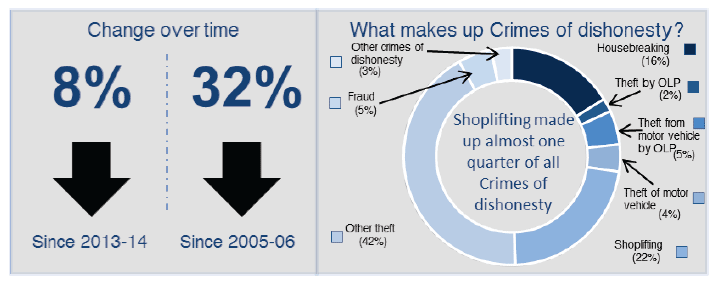
Number of Crimes of dishonesty recorded in 2014-15:
Crimes of dishonesty account for almost half (49%) of all crime recorded in Scotland in 2014‑15. Between 2013-14 and 2014-15, the number of Crimes of dishonesty recorded by the police in Scotland decreased by 8%, from 137,324 to 126,857.
Chart 11 below shows the number of Crimes of dishonesty from 1971 onwards. Levels of Crimes of dishonesty increased for a long period, but have been on a generally downward trend since they peaked in 1991, having decreased by 71% since that time. These crimes are now at the lowest level since 1971, the first year for which comparable crime groups are available.
Chart 11: Crimes of dishonesty recorded by the police, 19711 to 1994 then 1995‑96 to 2014-15
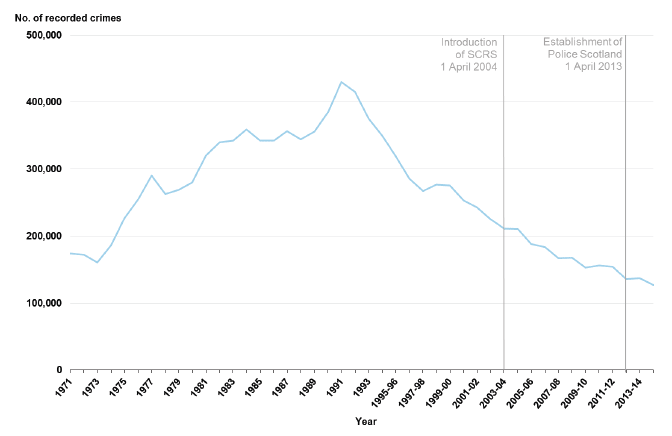
1. Crimes recorded for the present crime groups are not available prior to 1971.
The national rate for Scotland of recorded Crimes of dishonesty decreased from 258 per 10,000 population in 2013-14 to 237 crimes per 10,000 population in 2014-15. Rates varied significantly by local authority area, with the highest rate in 2014-15 seen in the City of Edinburgh (456 per 10,000 population), and the lowest in the Orkney Islands (44 per 10,000 population).
Chart 12 shows the four largest categories within Crimes of dishonesty over the last ten years, and gives an indication of the trend and scale of each category. Although the level of all four of these categories have decreased over time, the proportions of Shoplifting and Other theft have increased over the ten year period from 2005-06 to 2014-15, while the others remained relatively steady throughout. Other theft has consistently been the biggest contributor to Crimes of dishonesty. While not displayed in Chart 12, the proportions of Theft by opening a lockfast place (OLP), Theft from a motor vehicle by OLP and Theft of a motor vehicle have decreased over the ten years from 2005-06 to 2014-15 (Table 5).
Chart 12: Crimes of dishonesty (showing four largest categories) in Scotland, 2005-06 to 2014-15
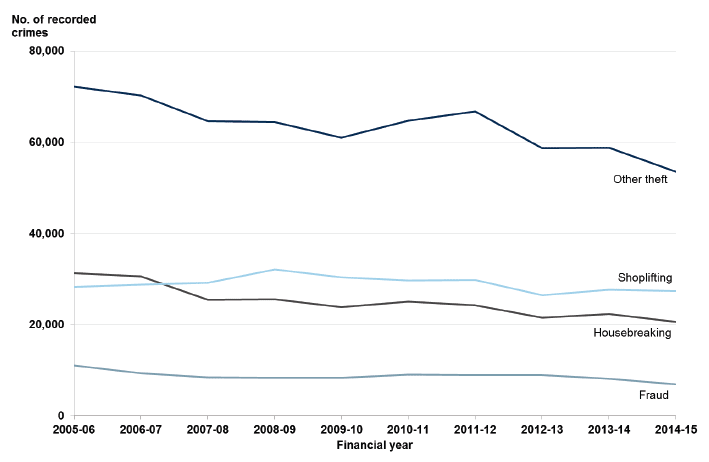
Other theft:
Other theft includes Theft of pedal cycles and other thefts which are not classified elsewhere.
This category is the largest in Crimes of dishonesty, and accounts for 42% of these crimes. Over the ten year period from 2005-06 to 2014-15, Other theft has seen a decrease of 26%, and has decreased by 9% from 58,794 in 2013-14 to 53,539 in 2014-15.
All but four local authority areas recorded a decrease in this category over the ten year period. This trend continued between 2013-14 and 2014-15 with all but six local authorities showing a decrease from the previous year.
Shoplifting:
Shoplifting accounts for a fifth (22%) of Crimes of dishonesty. Over the ten year period from 2005-06 to 2014-15, Shoplifting has seen a decrease of 3%, and has decreased by 1% from 27,693 in 2013-14 to 27,364 in 2014-15. However this is the only category in Crimes of dishonesty not to show a clear downward trend, having remained comparatively stable over the ten year period.
There was wide variation in the change across the 32 local authorities over the ten year period, with over half (19) showing a decrease in Shoplifting. This variation is also reflected between 2013-14 and 2014-15 with less than half (14) of Scotland's local authorities recording a decrease.
Housebreaking:
Housebreaking accounts for 16% of Crimes of dishonesty. Over the ten year period from 2005-06 to 2014-15, this crime has seen a decrease of 34%, and has decreased by 7% from 22,272 in 2013-14 to 20,607 in 2014-15. Table A4 shows that this has been driven by a decrease of 11% in housebreaking of domestic dwellings.
All but four local authority areas recorded a decrease in this category over the ten year period. Notably, after showing a generally downward trend for most of the ten year period, the City of Edinburgh has recorded an increase for two consecutive years, having increased by 67% since 2012-13 and 21% since 2013-14. The City of Edinburgh, which includes 9% of Scotland's population[6], accounts for almost a quarter (24%) of crimes within this category. Between 2013-14 and 2014-15, almost two thirds (21) of local authorities showed a decrease.
Additional information provided by Police Scotland relating to Housebreaking is available in the 'Data Considerations' section below.
Fraud:
Crimes of Fraud account for 5% of Crimes of dishonesty. Over the ten year period from 2005-06 to 2014-15, this category has fluctuated but overall has seen a decrease of 38%, and has decreased by 15% between 2013-14 and 2014-15.
All but three local authority areas recorded a decrease in this category over the ten year period. This trend continued between 2013-14 and 2014-15, with all but seven local authorities showing a decrease.
Theft from a motor vehicle by opening a lockfast place (OLP):
Theft from a motor vehicle by OLP accounts for 5% of Crimes of dishonesty. Over the ten year period from 2005-06 to 2014-15, this crime has seen a large decrease of 65%, and has decreased by 6% from 6,189 in 2013-14 to 5,816 in 2014-15.
All but one local authority area recorded a decrease in this category over the ten year period. Between 2013-14 and 2014-15, over two thirds (22) of local authorities showed a decrease. The largest increase was seen in East Dunbartonshire (88%), although this is mainly due to a very low figure in 2013-14, with the figure for 2014-15 remaining well below other years in the ten year period.
Theft of a motor vehicle:
Theft of a motor vehicle accounts for 4% of Crimes of dishonesty. Over the ten year period from 2005-06 to 2014-15, this crime has seen a large decrease of 61%, having been on a generally downward trend since 2006-07, and has decreased by 9% from 5,976 in 2013-14 to 5,423 in 2014-15.
All local authority areas recorded a decrease in this category over the ten year period. Between 2013-14 and 2014-15, three quarters (24) of all local authorities showed a decrease. Of those that increased, the largest was found in Stirling (57%), although this is mainly due to a low figure in 2013-14, with 2014-15 being more in line with data prior to that reporting year.
Additional information provided by Police Scotland relating to vehicle theft is available in the 'Data Considerations' section below.
Theft by opening a lockfast place (OLP):
Theft by opening a lockfast place (OLP) accounts for 2% of Crimes of dishonesty. Over the ten year period from 2005-06 to 2014-15, this crime has seen a large decrease of 65%, and has decreased by 11% from 3,218 in 2013-14 to 2,879 in 2014-15.
With the exception of Argyll & Bute, all local authority areas recorded a decrease in this category over the ten year period. Argyll & Bute has been on a downward trend since 2008-09, but has increased for two consecutive years with a 100% increase between 2013-14 and 2014-15.
Additional information provided by Police Scotland relating to Theft by opening a lockfast place in Argyll & Bute is available in the 'Data Considerations' section below.
Between 2013-14 and 2014-15, almost two thirds (21) of local authorities showed either a decrease or very little change from the previous year.
Other crimes of dishonesty:
Other crimes of dishonesty includes Reset, Corruption, Embezzlement and other crimes of forgery which are not classified elsewhere.
Other crimes of dishonesty account for 3% of total Crimes of dishonesty. Over the ten year period from 2005-06 to 2014-15, this crime has seen a decrease of 31%, and has decreased by 15% from 5,094 in 2013-14 to 4,316 in 2014-15.
All but five local authority areas either recorded a decrease or very little change in this category over the ten year period. This trend continued between 2013-14 and 2014-15, as over two thirds (22) of local authorities showed a decrease or very little change from the previous year.
Clear up rates for Crimes of dishonesty in 2014-15:
The clear up rate for Crimes of dishonesty decreased by 1.6 percentage points in 2014-15, from 37.4% to 35.8%. The clear up rate for these crimes has fluctuated slightly year to year, and is currently at the lowest level seen in the ten year period from 2005-06 to 2014-15. The clear up rate for Crimes of dishonesty ranged from 74.6% in the Shetland Islands to 25.4% in the City of Edinburgh.
Clear up rates in almost all categories in this crime group have also decreased, with only Housebreaking seeing an increase, from 23.2% in 2013-14 to 25.0% in 2014-15.
Police Scotland advised that operations such as the high profile Operation RAC, Operation Ruby in Aberdeen City and Aberdeenshire & Moray Divisions and Operation TUSKER in Fife Division are thought to have contributed to the overall drop in Crimes of dishonesty. Operation RAC involved investigative resources dedicated to reducing and responding to Housebreaking. Operation Ruby targeted offenders of vehicle theft, which often involved those who entered insecure dwellings as part of the crime. Operation TUSKER targeted seasonal crimes through raising awareness amongst local communities around personal security in warmer weather (e.g. open windows, etc.).
Police Scotland have also advised that operations such as these have resulted in repeat offenders receiving custodial sentences, which may have led to fewer crimes being committed.
As part of the production of this Bulletin, Police Scotland have fed back that a single report in Argyll & Bute resulted in 31 separate recorded crimes of Theft by opening a lockfast place. This was in relation to repeated thefts at the same location.
DATA VALIDATION
HMICS Crime Audit 2014
The 2014 Crime Audit carried out by HMICS included a specific focus on housebreaking. Of the 1,341 crimes examined in the audit that resulted from housebreaking incidents, 95% were counted and classified correctly.
The audit report stated that this 'good Test 2 compliance rate reflects the fact that housebreaking incidents appear to be scrutinised carefully by crime management units and are therefore more likely to be accurate'.
Most Test 2 errors related to the classification of the crime, and most of these related to whether the security of the building had been overcome (see page 24 of the HMICS report for further information).
Of the 1,664 incidents[7] examined, 94% were closed correctly. Around half of the incidents which failed Test 1 did so because the incident record had not been updated with the results of the enquiry and the initial inference of criminality had not been dispelled. Around a quarter of Test 1 fails were thought to be crimes where the incident had not been followed up or the complainers had become uncooperative. Other Test 1 errors included incidents where the items stolen were deemed to be of no monetary value and therefore did not merit a crime report and where the owner of the property broken into was reporting the break-in 'for information only'.
Non-crime related incidents
Non-crime related incidents are those incidents reported to the police which never result in a crime report. Because there are no crime reports, this category can only be assessed against Test 1. Of the 1,254 such incidents examined, 87% were closed correctly. These incidents related to areas of inquiry that spanned all of the crime groups, but the Audit highlighted two areas specific to Crimes of dishonesty.
Several of the incidents where a crime had clearly been committed but no crime record was found related to shoplifting. Often the goods stolen were of low value and officers elected not to record a crime, often because it was unlikely the offender would have been prosecuted. However, the decision to record a crime is distinct from the decision to prosecute. In these cases, HMICS viewed that a crime should still have been recorded.
Other incidents where a crime had clearly been committed but no crime record was found related to fraud. It seemed that some officers were uncertain how to respond to fraud allegations, particularly in relation to online fraud. The issue of fraud and cybercrime is one that HMICS has said they will consider more broadly in future. While the statistics in this bulletin show that crime is falling, there is a fear that some crime is being displaced and is now taking place online where it can be more challenging to identify, record and investigate. HMICS have stated that it will consider this type of crime further when setting their scrutiny programme in future.
Further information on this audit, including definitions of terminology and tests used, can be found in Annex 3.
DATA COMPARISONS
In addition to information on police recorded Crimes of dishonesty, the Scottish Crime and Justice Survey (SCJS) provides a complimentary outlook on some Crimes of dishonesty through asking respondents about their experiences of property crime.
A more detailed examination of comparisons between the SCJS and recorded crime is made within Chapter 4.
Key points from the Scottish Crime and Justice Survey:
Of the 815,000 crimes measured by the SCJS in 2012-13, 579,000 (71%) were property crimes. It is estimated that around 15% of adults in Scotland were a victim of property crime in 2012-13.
In 2012-13, vandalism accounted for 27% of property crime, followed by other household theft (including bicycle theft, 21%), personal theft (excluding robbery, 13%), all motor vehicle theft related incidents (6%) and housebreaking (4%).
Further detail on the comparable crime set is available in Section 4.3. As outlined there and in Annex 5 of the 2012-13 SCJS, the comparable acquisitive crime group in the SCJS includes theft or damage to personal or household property (including vehicles) which are included in a number of recorded crime groups, including Group 3 (Crimes of dishonesty) and Group 7 (Motor vehicle offences).
As presented in Section 4.3, results show that recorded acquisitive crime decreased by 21% between 2008-09 and 2012-13; however, the SCJS estimates of acquisitive crime showed no statistically significant change between 2008-09 and 2012-13 (the apparent change from 64,000 to 73,000 is not statistically significant). Survey estimates on the comparable crime subgroups are based on small base sizes of respondents (272 for acquisitive crime in 2012-13) and as a consequence, there is less certainty around estimates.
Group 4 - Fire-raising, Vandalism etc.
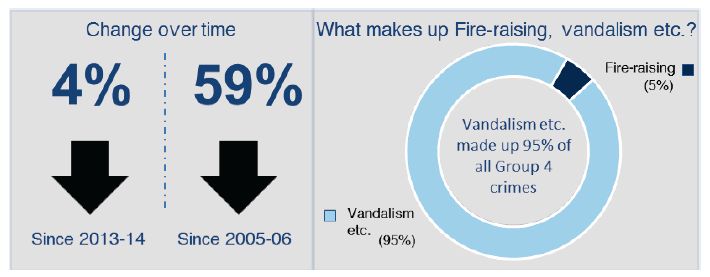
Number of crimes of Fire-raising, vandalism etc. recorded in 2014-15:
Fire-raising, vandalism etc. accounts for one fifth (20%) of all crime recorded in Scotland in 2014‑15. Between 2013-14 and 2014-15, the number of crimes of Fire-raising, vandalism etc. recorded by the police in Scotland decreased by 4%, from 54,418 to 52,091.
Chart 13 below shows the number of crimes of Fire-raising, vandalism etc. from 1971 onwards. Levels of Fire-raising, vandalism etc. increased for a long period, but have been on a sharp downward trend since they peaked in 2006-07, having decreased by 60% since that time. These crimes are now at the lowest level since 1978.
Chart 13: Crimes of Fire-raising, vandalism etc. recorded by the police, 19711 to 1994 then 1995‑96 to 2014-15
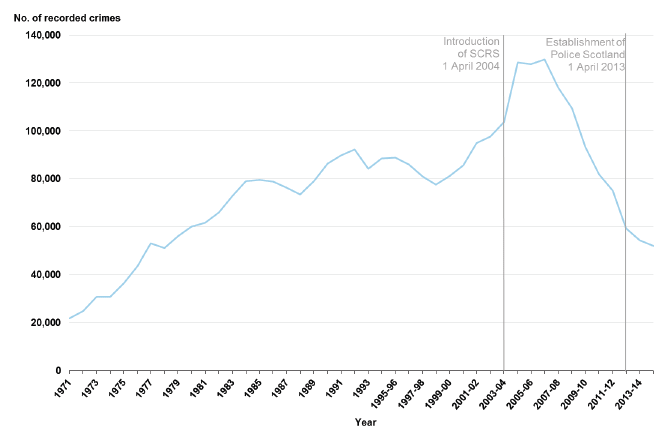
1. Crimes recorded for the present crime groups are not available prior to 1971.
In 2014-15, the rate for Scotland of recorded crimes of Fire-raising, vandalism etc. decreased to 97 crimes per 10,000 population, compared to 102 per 10,000 population for 2013-14. This varied by local authority area, with the highest rate in Glasgow City (140 per 10,000 population), and the lowest in Eilean Siar (39 per 10,000 population).
Due to the difference in scale of recorded crimes of Vandalism etc. and Fire-raising, Charts 14 and 15 show these two categories separately to highlight better the similar downward trends they have followed over the last ten years.
Chart 14: Fire-raising in Scotland, 2005-06 to 2014-15
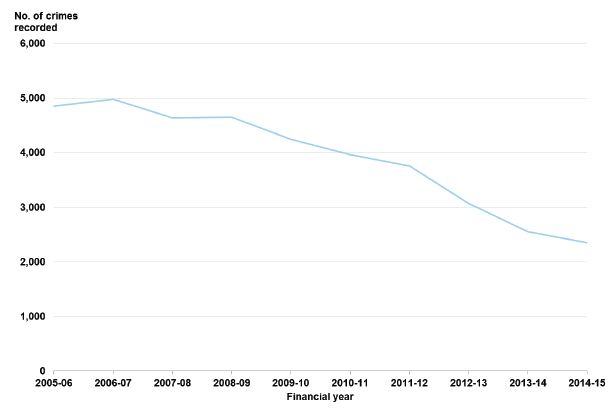
Chart 15: Vandalism etc. in Scotland, 2005-06 to 2014-15
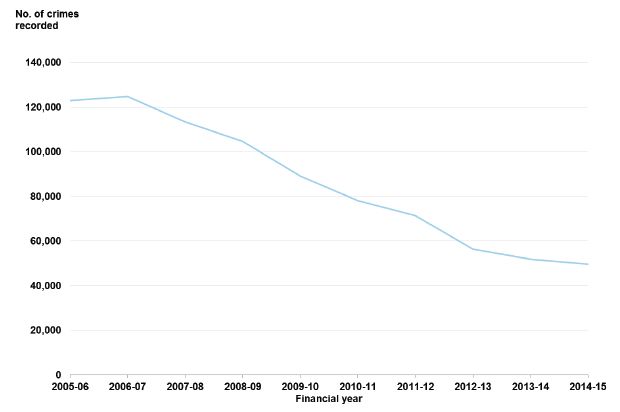
Vandalism etc.:
Vandalism etc. makes up over 95% of crimes of Fire-raising, vandalism etc. Over the ten year period from 2005-06 to 2014-15, this crime has seen a large decrease of 60%, and has decreased by 4% from 51,869 in 2013-14 to 49,740 in 2014-15.
All local authority areas recorded a decrease in this category over the ten year period, ranging from 47% in Stirling to 74% in East Dunbartonshire. Between 2013-14 and 2014-15, more than three quarters (26) of local authorities showed a decrease or very little change from the previous year.
Fire-raising:
Fire-raising accounts for less than 5% of crimes of Fire-raising, vandalism etc. Over the ten year period from 2005-06 to 2014-15, this crime has seen a large decrease of 52%, and has decreased by 8% from 2,549 in 2013-14 to 2,351 in 2014-15.
All local authority areas recorded a decrease in this category over the ten year period, ranging from 12% in Stirling to 83% in the Shetland Islands. Between 2013-14 and 2014-15, more than two thirds (23) of local authorities showed a decrease or very little change from the previous year.
Clear up rates for Fire-raising, vandalism etc. in 2014-15:
The clear up rate for Fire-raising, vandalism etc. decreased by 2.3 percentage points in 2014-15 from 25.1% to 22.8%. Crimes of Fire-raising, vandalism etc. consistently have the lowest clear up rate of the five crime groups. The 2014-15 clear up rate for Fire-raising, vandalism etc. ranged from 60.6% in the Shetland Islands to 13.6% in East Renfrewshire.
DATA COMPARISONS
This segment includes information that should be considered to widen contextual understanding of the data provided on Group 4 - Fire-raising, vandalism etc. Detail is provided on the number of fires which are attended to by the Scottish Fire and Rescue service, as well as analysis from the Scottish Crime and Justice Survey (SCJS) to provide a complementary outlook on vandalism in Scotland.
Fire and Rescue Statistics Scotland
As highlighted above, there has been a 52% reduction in the number of fire-raising crimes recorded by the police between 2005-06 and 2014-15, from 4,856 to 2,351. Another source of statistics on fire in Scotland is an annual publication covering the number of fires attended by the Scottish Fire and Rescue Service (SFRS). The latest figures (for 2013-14) are available at: http://www.gov.scot/Publications/2014/12/2384/0.
It is not possible to make direct comparisons between the two sources, as many fires are caused accidentally rather than as a result of a crime, and the police are not called to all deliberate fires. Furthermore, not all police recorded crimes of fire-raising may result in the attendance of the SFRS (for example, the fire may have ended before the police attended). However as these sources both relate to how Scotland's emergency services respond to fire, it would be anticipated that both should show similar trends over time.
A total of 27,979 fires were attended by the SFRS in 2013-14, of which over 16,000 were started deliberately. This represents a 42% reduction in the total number of fires attended since 2005-06 and a 30% reduction in the number of deliberate fires since 2009-10 (the first year for which comparable data are available). This comparison confirms that the significant reduction in police recorded crimes of fire-raising over the past 10 years has also been broadly reflected in statistics for the SFRS.
Scottish Crime and Justice Survey (SCJS)
In addition to the information on police recorded crime, the SCJS provides a complimentary outlook through asking respondents about their experiences of vandalism in Scotland.
A more detailed examination of comparisons between the SCJS and recorded crime is made within Chapter 4.
Key points from the Scottish Crime and Justice Survey:
As stated earlier, of the 815,000 crimes measured by the SCJS in 2012-13, 579,000 (71%) were property crimes and it is estimated that around 15% of adults in Scotland were a victim of property crime in 2012-13.
In 2012-13, vandalism accounted for 27% of property crime, followed by other household theft (including bicycle theft, 21%), personal theft (excluding robbery, 13%), all motor vehicle theft related incidents (6%) and housebreaking (4%).
Further detail on the comparable crime group is available in Section 4.3 and in Annex 5 of the 2012-13 SCJS. Vandalism is included in recorded crime figures within Group 4 (Fire-raising, vandalism etc).
As shown in Section 4.3, between 2008-09 and 2012-13, recorded vandalism figures fell by 46%, while SCJS estimates decreased significantly by 37%. Compared to the violent crime and acquisitive crime groups, vandalism estimates are based on larger samples of respondents (760 in the 2012-13 survey), leading to greater certainty around changes in the short and medium term.
Group 5 - Other Crimes
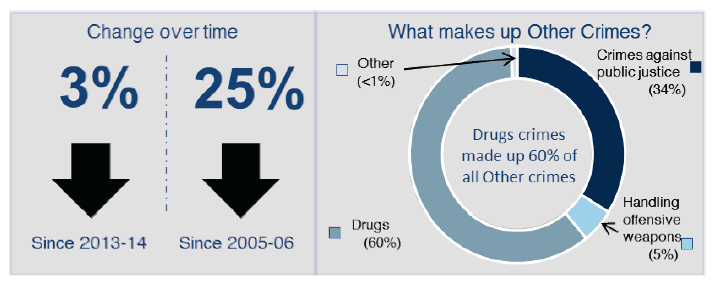
Number of Other crimes recorded in 2014-15:
Other crimes account for almost one quarter (24%) of all crimes recorded in Scotland in 2014‑15. Between 2013-14 and 2014-15, the number of Other crimes recorded by the police in Scotland decreased by 3%, from 63,266 to 61,488. This was largely driven by a decrease of 11% in Crimes against public justice.
Chart 16 below shows the number of Other crimes from 1971 onwards. Levels of these crimes increased for a long period, but has been on a generally downward trend since they peaked in 2006-07, having decreased by 28% since that time. These crimes are now at the lowest level since 2000-01.
Chart 16: Other crimes recorded by the police, 19711 to 1994 then 1995‑96 to 2014-15
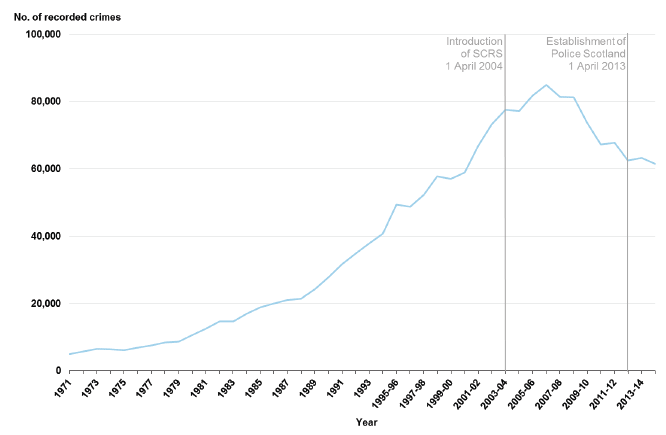
1. Crimes recorded for the present crime groups are not available prior to 1971.
In 2014-15, the rate for Scotland of recorded Other crimes decreased to 115 crimes per 10,000 population, compared to 119 per 10,000 population for 2013-14. This varied by local authority area, with the highest rate in Glasgow City (233 per 10,000 population), and the lowest in the Orkney Islands and Eilean Siar (37 per 10,000 population).
Chart 17 shows the four categories within Other crimes over the last ten years, and gives an indication of the trend and scale of each category. The proportion of Drugs crimes have increased over the ten year period from 54% in 2005-06 to 60% in 2014-15, while that of Handling offfensive weapons has decreased (from 12% in 2005-06 to 5% in 2014-15), with the others remaining relatively steady throughout. Drugs crimes has consistently been the biggest contributor to Other crimes.
Chart 17: Other crimes in Scotland, 2005-06 to 2014-15
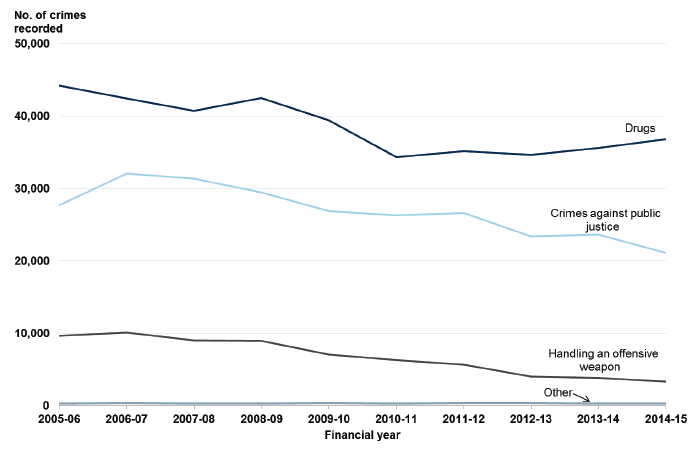
Drugs:
Drug crimes is the largest category in Group 5, accounting for 60% of Other crimes in 2014‑15. This category has seen a decrease of 17% over the ten year period from 2005-06 to 2014-15, but has increased by 3% from 35,616 in 2013-14 to 36,836 in 2014-15. These crimes have increased for two consecutive years, and are now at the highest level since 2009-10.
Over the ten year period, all but five local authorities recorded a decrease in this category. This trend was not continued between 2013-14 and 2014-15 with less than half (14) of local authorities showing a decrease or very little change from the previous year.Notably, levels in Renfrewshire have increased by 77% over the ten year period, and has shown an upward trend since 2011-12, having increased by 30% from 1,557 in 2013-14 to 2,021 in 2014-15. While this local authority accounts for 5% of the crimes in this category, this increase is the equivalent of 38% of the overall change in Drug crimes.
Additional information provided by Police Scotland relating to Drug crimes in Renfrewshire is available in the 'Data Considerations' section below.
Crimes against public justice:
Crimes against public justice includes Bail offences, Resisting arrest and wasting police time.
Crimes against public justice accounts for 34% of Other crimes in 2014‑15. This category has seen a decrease of 24% over the ten year period from 2005-06 to 2014-15, and has decreased by 11% from 23,610 in 2013-14 to 21,100 in 2014-15.
Over the ten year period, all but five local authorities recorded a decrease in this category. This trend continued between 2013-14 and 2014-15 with all but six local authority areas showing a decrease. This was mainly driven by decreases in two crime codes: Resisting arrest; and Bail offences, other than absconding or re-offending.
Handling offensive weapons:
Crimes of Handling offensive weapons accounts for 5% of Other crimes in 2014‑15. This category has seen a decrease of 67% since 2006-07 when these crimes were at the highest level since 1971, the first year for which comparable data are available. This category has decreased by 13% from 3,795 in 2013-14 to 3,289 in 2014-15.
Over the ten year period, all local authorities recorded a decrease in this category, ranging from 29% in Dundee City to 85% in North Ayrshire and Moray. This trend continued between 2013-14 and 2014-15 with over two thirds (23) of local authority areas showing a decrease or very little change from the previous year.
Other:
The Other category within Other crimes includes Treason, Conspiracy, Explosive offences, Wrecking, piracy and hijacking, and Crimes against public order.
This category accounts for less than 1% of Other crimes in 2014-15. This category has fluctuated over time with a decrease of 3% over the ten year period from 2005-06 to 2014-15, and an increase of 7% from 245 in 2013-14 to 263 in 2014-15.
Clear up rates for Other crimes in 2014-15:
Clear up rates for Other crimes are generally close to 100% since these consist of many crimes for which someone is 'caught in the act'. The clear up rate for Other crimes decreased by 1.9 percentage points in 2014-15 from 98.4% to 96.5%, the lowest level in the ten year period covered by the bulletin. The clear up rate for Group 5 crimes ranged from 111.2% in the Shetland Islands to 90.6% in the City of Edinburgh.
Clear up rates in each of the four categories in this crime group have also decreased, with the largest decrease in the clear up rate noted in the Other category, decreasing from 94.7% to 90.5%.
Rates of of over 100% can occur when crimes are cleared up in a different reporting period to the year in which they were recorded.
As highlighted above, 38% of the national increase in Drug crimes was in the Renfrewshire local authority area. Police Scotland advise that the increase in drug related crimes in Renfrewshire relates mainly to the possession of drugs, recorded as a result of pro-active and intelligence led policing activity, including stop and search patrols in hotspot areas. Additionally, Police Scotland advise that the pro-active monitoring of breaches of bail conditions may have contributed to an increase in the number of drug crimes being recorded in Renfrewshire.
Total Recorded Offences
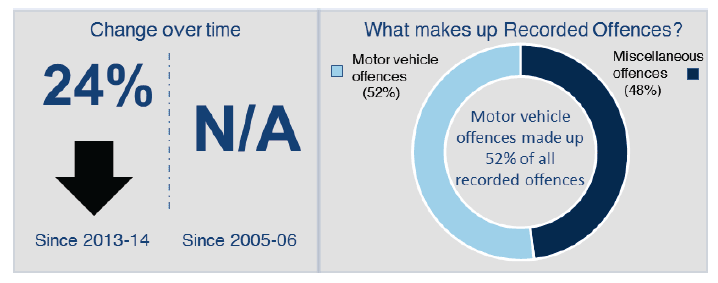
Total number of offences recorded in 2014-15:
Due to a number of anomalies in the data for Miscellaneous offences and Motor vehicle offences, data for the total recorded offences by the police are only comparable from 2013-14 onwards. Further detail on these anomalies can be found in the 'Data Considerations' sections below and in the following sections under each offence group, as well as in Annex 2.
The total number of offences recorded by the police in Scotland decreased by almost one quarter (24%) from 501,281 in 2013-14 to 379,498 in 2014-15 (Table 6).
The two groups account for almost equal proportions of the total number of offences, compared to 2013-14 when Motor vehicle offences accounted for just under 60% of the total.
Local Authority analysis:
Every local authority area, with the exception of the Shetland Islands, showed a decrease in recorded offences. The decreases ranged from 4% in Highland to 47% in East Dunbartonshire.
Further explanation of these trends is set out in the following sections under each offence group.
It should be noted that the number of offences recorded by the police generally tends to be affected more by police activity and operational decisions than the numbers of crimes.
Official Statistics on total recorded offences are based on data which Police Scotland extract from their IT system (called the Scottish Operational and Management Information System (ScOMIS)) and submit to the Scottish Government. Prior to 2013-14 and the establishment of Police Scotland, the Scottish Government collected recorded offences data from the eight legacy forces, who in turn extracted the data from their own systems.
Coinciding with this change of collection, the Scottish Government carried out an extensive data quality exercise to assess the comparability of data extracted from ScOMIS with the data published in previous bulletins. This analysis identified that a number of offence codes are non-comparable over time. For Group 6, Miscellaneous Offences, all data are fully comparable from 2008-09 onwards. For Group 7, Motor Vehicle Offences and hence the overall figures on Offences (based on Group 6 and 7), data are only comparable from 2013-14 onwards.
The Scottish Government produced a Technical Report in 2014 which detailed the quality assurance work it carried out in reaching this conclusion: http://www.gov.scot/Topics/Statistics/Browse/Crime-Justice/PubRecordedCrime/TechnicalReport.
Group 6 - Miscellaneous Offences
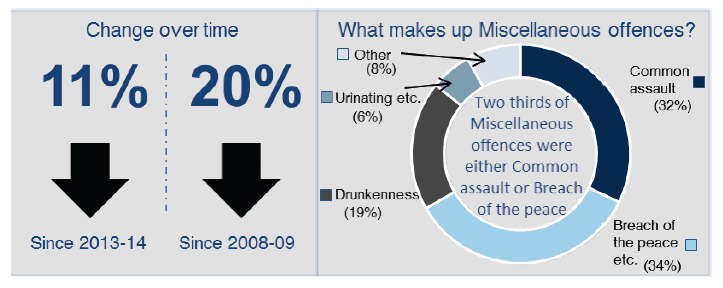
Number of Miscellaneous offences recorded in 2014-15:
Miscellaneous offences account for almost half (48%) of all offences recorded in Scotland in 2014‑15. Between 2013-14 and 2014-15, the number of Miscellaneous offences recorded by the police in Scotland decreased by 11%, from 207,190 to 183,513.
Due to a number of anomalies in the data for Miscellaneous offences, this group is only comparable from 2008-09 onwards. Further information on the comparability of Group 6 is available in the 'Data Considerations' section below, and in Annex 2.
In 2014-15, the rate for Scotland of recorded Miscellaneous offences decreased to 343 crimes per 10,000 population, compared to 389 per 10,000 population for 2013-14. This varied by local authority area, with the highest rate in Glasgow City (841 per 10,000 population), and the lowest rate in East Renfrewshire (130 per 10,000 population).
Chart 18 shows the four categories within Miscellaneous offences over the last ten years for Breach of the peace etc., Common assault and Urinating etc., and from 2008-09 for Drunkenness and other disorderly conduct and Other miscellaneous offences. This chart gives an indication of the trend and scale of each category. The proportion of Drunkenness and other disorderly conduct and Urinating etc.have increased since 2008-09, while that of Breach of the peace etc. has decreased, with the others remaining relatively steady throughout. Breach of the peace etc. and Common assault have consistently been the biggest contributors to Miscellaneous offences.
Breach of the peace etc.:
Breach of the peace etc. includes Breach of the peace, Threatening or abusive behaviour, Offence of stalking, Offensive behaviour at football and Threatening communications. A further breakdown of Breach of the peace etc. into its component parts is available in Table A8.
Chart 18: Miscellaneous offences in Scotland, 2005-06 to 2014-15
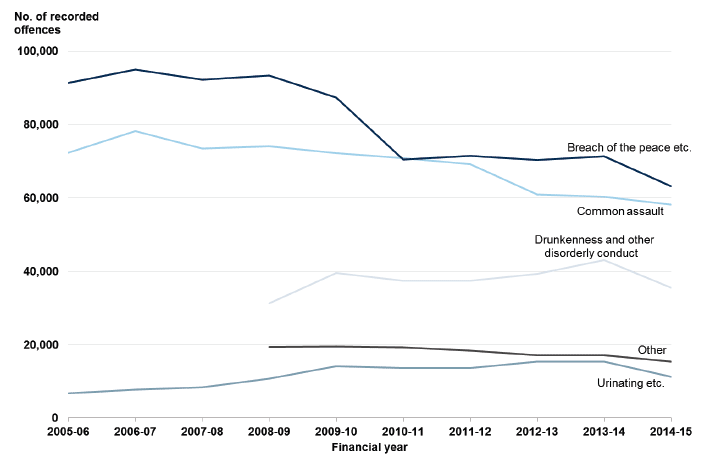
Breach of the peace etc. is the largest category in Miscellaneous offences, accounting for more than a third (34%) of Miscellaneous offences in 2014-15. Over the ten year period from 2005-06 to 2014-15, this category has fallen by 31%, and has decreased by 11% from 71,288 in 2013-14 to 63,205 in 2014-15.
All but two local authority areas recorded a decrease or very little change in this category over the ten year period. Between 2013-14 and 2014-15, more than three quarters (26) of local authorities showed a decrease.
In 2014-15, the rate for Scotland of recorded Breach of the peace etc. was 118 offences recorded per 10,000 population. This varied by local authority area, with the highest rate in Glasgow City (219 per 10,000 population), and the lowest in Aberdeenshire (42 per 10,000 population).
Common assault:
Common assault accounts for 32% of Miscellaneous offences. Over the ten year period from 2005-06 to 2014-15, this offence has seen a decrease of 20%, and has decreased by 4% from 60,357 in 2013-14 to 58,178 in 2014-15.
All but four local authority areas recorded a decrease or very little change in this category over the ten year period. Between 2013-14 and 2014-15, three quarters (24) of local authorities showed a decrease or very little change from the previous year.
In 2014-15, the rate for Scotland of recorded Common assault was 109 offences recorded per 10,000 population. This varied by local authority area, with the highest rate in Glasgow City (160 per 10,000 population), and the lowest in East Renfrewshire (39 per 10,000 population).
For the distinction between Common assault and Serious assault please see Paragraph 6.9 within Annex 1.
Drunkenness and other disorderly conduct:
Drunkenness and other disorderly conduct includes offences such as Drunk and Incapable, Disorderly on licensed premises and Consumption of alcohol in designated places, byelaws prohibited. For further information on the classification of crimes and offences, please see Chapter 7.
Drunkenness and other disorderly conduct accounts for 19% of Miscellaneous offences. Between 2008-09 and 2014-15, levels of this crime have fluctuated, but are currently 13% higher than 2008-09. Since 2013-14, this category has decreased by 17% from 43,043 to 35,524 in 2014-15. The largest numerical change was in Glasgow City (down 17%, from 23,549 in 2013-14 to 19,587 in 2014-15) which accounts for 55% of all crime in this category.
Three quarters (24) of local authority areas recorded a decrease or very little change in this category between 2008-09 and 2014-15. Between 2013-14 and 2014-15, all but five local authorities showed a decrease.
In 2014-15, the rate for Scotland of recorded Drunkenness and other disorderly conduct was 66 offences recorded per 10,000 population. This varied by local authority area, with the highest rate in Glasgow City (327 per 10,000 population), and the lowest in Angus (1 per 10,000 population).
It should be noted that the category Drunkenness and other disorderly conduct is not considered comparable for years prior to 2008-09. This is due to double counting of offences of Disorderly on licensed premises in legacy Tayside, and it has not been possible to correct these data prior to 2008-09. Further information on quality issues is available in the 'Data Considerations' section below, and in Annex 2.
Urinating etc.:
Urinating etc. accounts for 6% of Miscellaneous offences. This category followed a generally increasing trend for several years from 2005-06, peaking in 2012-13 and remaining at the same level in 2013-14. However, Urinating etc. decreased by 27% from 15,361 in 2013-14 to 11,216 in 2014-15.
Between 2013-14 and 2014-15, all local authorities showed a decrease or very little change from the previous year.
In 2014-15, the rate for Scotland of recorded Urinating etc. was 21 offences recorded per 10,000 population. This varied by local authority area, with the highest rate in Glasgow City (89 per 10,000 population), and the lowest in Perth & Kinross (2 per 10,000 population).
Other miscellaneous offences
The Other miscellaneous offences category includes a wide range of offences, including Racially aggravated harassment, Racially aggravated conduct, False/hoax calls, Offences invoving children and Offences involving animals/plants. For further information on the classification of crimes and offences, please see Chapter 7.
Other miscellaneous offences account for 8% of Miscellaneous offences. This category has seen a decrease of 21% between 2008-09 and 2014-15, and has reduced by 10% from 17,141 in 2013-14 to 15,390 in 2014-15.
All but five local authority areas recorded a decrease between 2008-09 and 2014-15. Between 2013-14 and 2014-15, three quarters (24) of local authorities showed a decrease or very little change from the previous year.
In 2014-15, the rate for Scotland of recorded Other miscellaneous offences was 29 offences recorded per 10,000 population. This varied by local authority area, with the highest rate in Aberdeen City (51 per 10,000 population), and the lowest in the Orkney Islands (10 per 10,000 population).
It should be noted that the Other miscellaneous offences category is not considered comparable for years prior to 2008-09. This is due to a very slight undercount for Litter offences and Bicycles, other offences in legacy Lothian & Borders data, as well as double counting of offences of Control of Pollution in legacy Tayside. It has not been possible to correct these issues prior to 2008-09. Further information on quality issues is available in the 'Data Considerations' section below, and in Annex 2.
As outlined in the overall section on police recorded offences - an extensive data quality exercise was carried out to assess the comparability of data extracted from the Scottish Operational and Management Information System (ScOMIS) with data collected from legacy police forces and published in previous bulletins. This analysis identified that all data for Group 6, Miscellaneous Offences, are fully comparable from 2008-09 onwards. However, two offences are non-comparable prior to 2008-09: Disorderly on licensed premises (within the Drunkenness and other disorderly conduct category) and Control of Pollution (within the Other miscellaneous offences category). Therefore, comparisons for the Drunkenness and other disorderly conduct and Other miscellaneous offences categories in Group 6 should also only be made for 2008-09 onwards. The comparability of the remaining three categories in Group 6: Common assault; Breach of the peace etc. and Urinating etc. are not affected.
The Scottish Government produced a Technical Report in 2014 which detailed the quality assurance work it carried out in reaching this conclusion: http://www.gov.scot/Topics/Statistics/Browse/Crime-Justice/PubRecordedCrime/TechnicalReport.
DATA VALIDATION
HMICS Crime Audit 2014
It should be noted that in the HMICS audit report, violent crime includes Common assault. Please refer to the Group 1 - Non-sexual crimes of violence section. Further information on this audit, including definitions of terminology and tests used, can be found in Annex 3.
As highlighted on page 16, the HMICS Crime Audit also included a review of Hate Crime. Of the 504 hate crimes examined, 94% were counted and classified correctly.
Five crimes were under-counted and six crimes were over-counted. There were no recurring themes in relation to counting errors for hate crime. However, the majority of classification errors related to the same technical issue around the classification of crimes between s.50(a) (1B) of the Criminal Law Consolidation (Scotland) Act 1005 and s.38 of the Criminal Justice and Licensing (Scotland) Act 2010.
The Test 1 compliance rate of 97% for hate crime was the best of the four crime categories audited.
Test 1 failures tended to relate to a lack of information or update on the incident record to dispel criminality. In several incidents, the complainer became uncooperative but a crime should nonetheless have been recorded. In a few incidents, a crime had clearly taken place but no trace of a crime record could be found.
DATA COMPARISONS
Racially aggravated harassment and conduct
The Other category in Miscellaneous offences contains offences of Racially aggravated harassment and Racially aggravated conduct, and Table A9 shows these offences for the last ten years. In 2014-15, there were 130 offences of Racially aggravated harassment and 2,326 offences of Racially aggravated conduct. While these are specific racially aggravated offences, they do not account for all racially aggravated crimes such as assault or vandalism.
The Racist Incidents Recorded by the Police in Scotland statistical bulletin series contains more detailed information on racist incidents such as victim/complainer and perpetrator characteristics, location of incident and the crimes recorded and cleared up as part of racist incidents.
We therefore recommend that users interested in racist incidents should refer directly to the Racist Incidents Recorded by the Police in Scotland bulletin series, available via the following link: http://www.gov.scot/Topics/Statistics/Browse/Crime-Justice/PubRacistIncidents.
The next Racist Incidents Recorded by the Police in Scotland bulletin will contain data for 2013-14 and is scheduled for publication in the Autumn of 2015. There are also plans to scope out what potential there is for a new and wider bulletin on the topic of Hate Crime.
Scottish Crime and Justice Survey (SCJS)
In addition to the information on police recorded crime, the SCJS provides a complimentary outlook on crimes of violence through asking respondents about their experiences.
As previously noted, violent crime as defined by the SCJS is not directly comparable with non-sexual crimes of violence recorded by the Police. Common assaults, which make up the majority of SCJS violent crime, are included in the Miscellaneous offences police recorded crime group, and the Non-sexual crimes of violence crime group includes homicide.
A more detailed examination of comparisons between the SCJS and recorded crime is made within Chapter 4.
Key points from the Scottish Crime and Justice Survey:
As stated under the Non-sexual crimes of violence section, of the 815,000 crimes measured by the SCJS in 2012-13, 236,000 (29%) were violent crimes and it is estimated that around 3% of adults in Scotland were a victim of violent crime in 2012-13.
In 2012-13, minor assaults made up the majority of SCJS violent crime (23%), followed by attempted assault (3%), serious assault (2%) and robbery (1%).
Further detail on the comparable crime set is available in Section 4.3. As outlined there and in Annex 5 of the 2012-13 SCJS, violent crime in the SCJS includes attempted assault, serious assault, minor assault and robbery, crimes which are included in Group 1 (Non-sexual crimes of violence) and Group 6 (Miscellaneous offences) in police recorded crime figures.
As presented in Section 4.3, between 2008-09 and 2012-13, recorded violent crime figures in the comparable category decreased by 20%, while, for the same period, the SCJS estimates of violent crime decreased by 25%, a statistically significant change in the SCJS results. As indicated by Table 3, the SCJS is often better able to detect changes in survey estimates with greater certainty over longer timescales, particularly where the prevalence of crime is low i.e. in part due to the small numbers of victims identified in the survey (343 for violent crime in 2012-13).
Group 7 - Motor Vehicle Offences
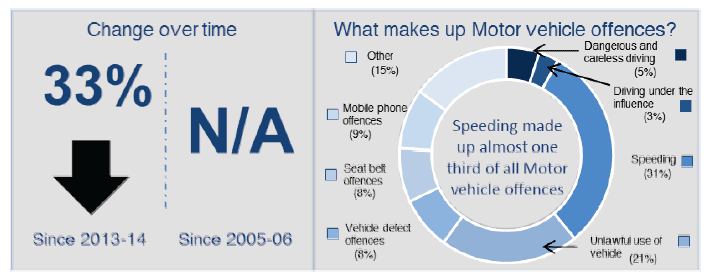
Number of Motor vehicle offences recorded in 2014-15:
Motor vehicle offences account for over half (52%) of all offences recorded in Scotland in 2014‑15. Between 2013-14 and 2014-15, the number of Motor vehicle offences recorded by the police in Scotland decreased by 33% from 294,091 to 195,985.
Due to a number of anomalies in the data as a result of inconsistencies with legacy data reporting, there is a break in the time series at 2013-14. Further information on the comparability issues can be found in the 'Data Considerations' section below, and detailed information on the comparability of Group 7 are available in Annex 2.
In 2014-15, the rate for Scotland of recorded Motor vehicle offences decreased to 366 crimes per 10,000 population, compared to 552 per 10,000 population for 2013-14. This varied by local authority area, with the highest rate in Dumfries & Galloway (721 per 10,000 population), and the lowest in Midlothian (112 per 10,000 population).
Additional information provided by Police Scotland relating to Motor vehicle offences is available in the 'Data Considerations' section below.
Speeding:
Speeding accounts for 31% of Motor vehicle offences. This category has decreased by 26% from 82,382 in 2013-14 to 60,926 in 2014‑15.
All but five local authority areas recorded a decrease or very little change between 2013-14 and 2014-15. The greatest numerical decrease was in South Lanarkshire (47%, from 10,524 in 2013-14 to 5,580 in 2014-15). South Lanarkshire accounts for 6% of Scotland's population[8].
In 2014-15, the rate for Scotland of recorded Speeding was 114 offences recorded per 10,000 population. This varied by local authority area, with the highest rate in Dumfries & Galloway (365 per 10,000 population), and the lowest in Midlothian (6 per 10,000 population).
It should be noted that the Speeding category is not considered comparable for years prior to 2013-14. This is due to the exclusion of certain data sources in legacy Strathclyde which affected the Speeding in restricted areas and Other speeding offences, and it has not been possible to correct these data prior to 2013-14. Further information on quality issues is available in Annex 2.
Unlawful use of vehicle:
The Unlawful use of vehicle category includes offences such as Driving while disqualified, Driving without a licence, Driving without insurance, and Driving without a test certificate. Further detail can be found in Chapter 7.
Unlawful use of vehicle accounts for 21% of Motor vehicle offences. This category has decreased by 29% from 57,779 in 2013-14 to 40,855 in 2014‑15.
All but two local authority areas recorded a decrease between 2013-14 and 2014-15.
In 2014-15, the rate for Scotland of recorded Unlawful use of vehicle offences was 76 offences recorded per 10,000 population. This varied by local authority area, with the highest rate in Glasgow City (156 per 10,000 population), and the lowest in East Dunbartonshire (29 per 10,000 population).
It should be noted that the Unlawful use of vehicle category is not considered comparable for years prior to 2013-14. This is due to the exclusion of certain data sources in legacy force returns, as well as double counting in legacy Lothian & Borders data, and it has not been possible to correct these data prior to 2013-14. These issues affect the following offences: Registration or identification mark offences, Vehicle Excise Licence offences, Using a motor vehicle without a test certificate, Driving without a licence (including under age) and Failure to insure against third party risks). Further information on quality issues is available in Annex 2.
Mobile phone offences:
Mobile phone offences account for 9% of Motor vehicle offences. Levels of these offences have increased each year since 2008-09, but decreased by 50% from 35,764 in 2013-14 to 17,978 in 2014-15, and are 25% lower than the number recorded in 2008-09.
Three quarters (24) of local authority areas recorded a decrease in this category between 2008-09 and 2014-15. All but two local authority areas showed a decrease or very little change between 2013-14 and 2014-15, with 16 local authorities decreasing by 50% or more.
In 2014-15, the rate for Scotland of recorded Mobile phone offences was 34 offences recorded per 10,000 population. This varied by local authority area, with the highest rate in Glasgow City (88 per 10,000 population), and the lowest in Midlothian (5 per 10,000 population).
It should be noted that the Mobile phone offences category is not considered comparable for years prior to 2008-09. This is due to the inclusion of invalid data in the returns from legacy Dumfries & Galloway and Fife, as well as double counting in legacy Lothian & Borders data, and it has not been possible to correct these data prior to 2008-09. Further information on quality issues is available in Annex 2.
Vehicle defect offences:
Vehicle defect offences account for 8% of Motor vehicle offences. This category has decreased by 25% from 20,923 in 2013-14 to 15,593 in 2014‑15.
All but three local authority areas recorded a decrease between 2013-14 and 2014-15.
In 2014-15, the rate for Scotland of recorded Vehicle defect offences was 29 offences recorded per 10,000 population. This varied by local authority area, with the highest rate in Clackmannanshire (246 per 10,000 population), and the lowest in East Dunbartonshire (3 per 10,000 population).
It should be noted that the Vehicle defect offences category is not considered comparable for years prior to 2013-14. This is due to the exclusion of certain data sources in legacy force returns, as well as the inclusion of invalid data in the returns from legacy Dumfries & Galloway and Fife, which affected the Lighting offences (motor vehicles) and Construction and use regulation (other than lighting) offences, and it has not been possible to correct these data prior to 2013-14. Further information on quality issues is available in Annex 2.
Seat belt offences:
Seat belt offences accounts for 8% of Motor vehicle offences. Levels of these offences had previously been on a generally upward trend since 2008-09, but have decreased by 59% from 37,880 in 2013-14 to 15,619 in 2014-15, and are 40% lower than the number recorded in 2008-09.
All but four local authority areas have recorded a decrease in this category between 2008-09 and 2014-15. All but one local authority area showed a decrease between 2013-14 and 2014-15, with 22 local authorities decreasing by 50% or more.
In 2014-15, the rate for Scotland of recorded Seat belt offences was 29 offences recorded per 10,000 population. This varied by local authority area, with the highest rate in Glasgow City (72 per 10,000 population), and the lowest in Midlothian (3 per 10,000 population).
It should be noted that the Seat belt offences category is not considered comparable for years prior to 2008-09. This is due to the inclusion of invalid data in the returns from legacy Dumfries & Galloway and Fife, as well as double counting in legacy Lothian & Borders data, and it has not been possible to correct these data prior to 2008-09. Further information on quality issues is available in Annex 2.
Dangerous and careless driving:
Dangerous and careless driving accounts for 5% of Motor vehicle offences. Between 2005-06 and 2014-15, levels of this category have fluctuated, but are currently 17% lower than 2005-06. Since 2013-14, this category has decreased by 7% from 11,524 to 10,773 in 2014-15.
Over half (19) of local authority areas recorded a decrease or very little change in this category between 2005-06 and 2014-15. Over two thirds (22) of local authorities showed a decrease or very little change between 2013-14 and 2014-15.
In 2014-15, the rate for Scotland of recorded Dangerous and careless driving was 20 offences recorded per 10,000 population. This varied by local authority area, with the highest rate in Argyll & Bute (47 per 10,000 population), and the lowest in Dundee City (7 per 10,000 population).
Driving under the influence:
Driving under the influence accounts for 3% of Motor vehicle offences. There was a 14% decrease in Driving under the influence from 6,079 in 2013-14 to 5,218 in 2014‑15, which continues the downward trend since 2006-07. Driving under the influence has decreased by 55% as a whole over this period.
All local authority areas recorded a decrease in this category between 2005-06 and 2014-15. Three quarters (24) of local authorities showed a decrease between 2013-14 and 2014-15.
In 2014-15, the rate for Scotland of the offence of Driving under the influence was 10 offences recorded per 10,000 population. This varied by local authority area, with the highest rate in the Shetland Islands (18 per 10,000 population), and the lowest in East Dunbartonshire, East Renfrewshire and the City of Edinburgh (6 per 10,000 population).
Other motor vehicle offences:
The Other motor vehicle offences category includes offences such as Accident offences and Parking offences. Further detail can be found in Chapter 7.
Other motor vehicle offences accounts for 15% of Motor vehicle offences. This category has decreased by 31% from 41,760 in 2013-14 to 29,023 in 2014‑15.
All but three local authority areas recorded a decrease or very little change between 2013-14 and 2014-15.
In 2014-15, the rate for Scotland of recorded Other motor vehicle offences was 54 offences recorded per 10,000 population. This varied by local authority area, with the highest rate in Glasgow City (155 per 10,000 population), and the lowest in Angus (12 per 10,000 population).
It should be noted that the Other motor vehicle offences category is not considered comparable for years prior to 2013-14. This is due to the exclusion of certain data sources in legacy Strathclyde which affected the Drivers neglect of traffic directions (not pedestrian crossing), Drivers contravention of pedestrian crossing regulations and Motorway traffic offences, and it has not been possible to correct these data prior to 2013-14. Further information on quality issues is available in Annex 2.
As outlined in the overall section on police recorded offences - an extensive data quality exercise was carried out to assess the comparability of data extracted from the Scottish Operational and Management Information System (ScOMIS) with data collected from legacy police forces and published in previous bulletins. This analysis identified that due to the standardisation of reporting practices following the establishment of Police Scotland, there are significant comparability issues for Group 7 Motor Vehicle Offences. There are no issues for two of the categories in Group 7: Dangerous and careless driving and Driving under the influence. Seat belt offences and Mobile phone offences are only comparable back to 2008-09. The other categories in Group 7 and hence the overall figures for Group 7 are only comparable back to 2013-14.
The Scottish Government produced a Technical Report in 2014 which detailed the quality assurance work it carried out in reaching this conclusion: http://www.gov.scot/Topics/Statistics/Browse/Crime-Justice/PubRecordedCrime/TechnicalReport.
In relation to the decrease overall in Motor vehicle offences, Police Scotland have advised that they have moved towards engagement and education to prevent road crime in addition to enforcement, with raising awareness and high profile media campaigns designed to influence driver behaviour and public attitudes. Further, Police Scotland state that high-risk road traffic offender groups are identified and targeted as part of routine business, and Anti-Social Behaviour legislation is used proactively, through the issue of initial warnings to drivers/vehicles followed by seizure of the vehicle where relevant.
Contact
Email: Keith Paterson
There is a problem
Thanks for your feedback